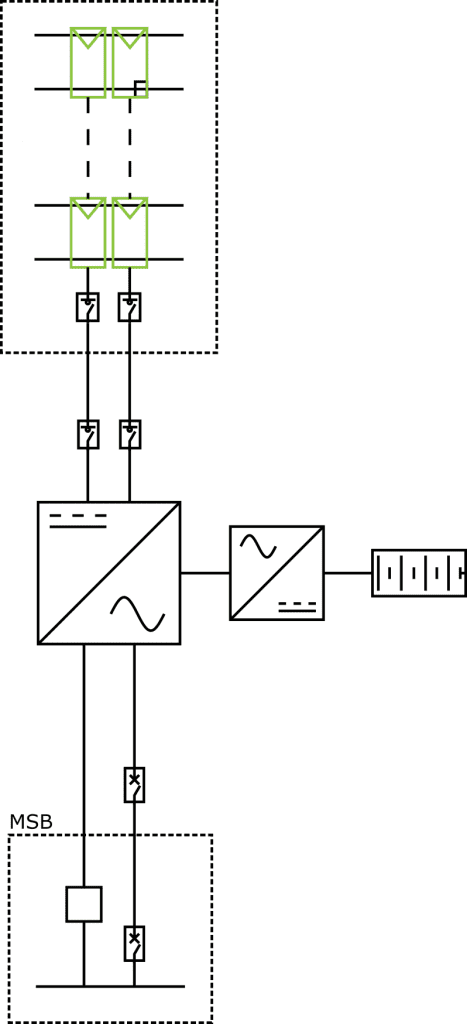This is just a short article to explain what you get when you buy a solar power system. If you want to learn more, visit our Education Centre!
Solar Panels

These generate the electricity. Loads of manufacturers available, from cheap rubbish made in China to expensive high-tech creations from Korea. Many different technologies, although the most common produced at commercial levels are monocrystalline (silicon) PERC and can be up to about 23% efficient. In the lab they are up to almost 50% efficiency, but these are not available yet – too expensive, too fragile, too short-lived.
Find out more about solar panels here.
Balance of System (BoS)
Everything that isn’t the solar panels. This includes:
Racking

This keeps the panels attached to the roof (or ground). Bill-busters may get cheap racking to save money (it all looks pretty much the same), but more expensive racking (such as Clenergy) ensures your system stays in your roof, whatever the weather, for the life of the system. This should be corrosion-resistent, cyclone-rated, and is usually made from aluminium and steel. Can be black, if you prefer.
Find out more about racking here.
Inverter

This converts the DC electricity generated by the solar panels to AC electricity needed for your house and the grid. Come from 1kW to 100kW+, cheap Chinese to expensive European. Most are 95%+ efficient, although better ones are more reliable and allow more flexible system design. The biggest danger to an inverter is heat, so the best ones have large heat sinks for passive cooling or fans for active cooling, and they should be installed out of direct sunlight.
Find out more about inverters here.
Wires/Cables

These connect everything together. You need a lot of different types of wire – DC wire and AC wire, correctly sized depending on system power and wire length, as well as correct connector types. You also need communication wiring for data and control. Potentially you’ll also need wireless kits to communicate, for example if your system is installed on another building to your main switchboard.
Switches/Isolators/Circuit Breakers

To turn on/off individual parts of the system. These are a safety feature, and mandatory by law. If you don’t have them, or you get cheap components, you risk electrical shorts, fires, and electrocution. There are ones on your rooftop, ones next to your inverter, and ones in your switchboard. Cheap ones fail, leak, and can even blow up or set on fire.
Battery Charger

Can be built into the inverter (a “hybrid” inverter), or separate (and added later). As the name suggests, it is used to charge (and discharge) a battery – basically, it converts from AC to DC and vice-versa, much like the inverter. Better ones are more efficient and can charge/discharge a battery faster – a cheap one may not discharge fast enough to power your power-hungry appliances.
Battery

Optional. Stores excess energy. These days they are usually made from lithium-ion, although lead-acid is still popular. For a solar install, they usually range from ~3kWh to hundreds of even thousands of kWh (most household solar installs have 6~10kWh; an electric car is 50~75kWh). Like the battery charger, they have a maximum charge/discharge rate.
Find out more about batteries here.
Monitoring & Control

Most simple systems don’t have an additional monitoring or control hardware, although larger or more complex systems can. This can include: an energy meter to monitor your household consumption; a timer, to make certain devices work only at certain times (e.g. hot water); a power diverter, to intelligently divert excess solar to specified appliances; network protection, to help grid stability (required for systems >30kVA); and more.
Optimisers

Another optional extra, this enables you to get the most out of every panel on your roof. A box containing specialised electronics maximises the power output of each panel, and the system as a whole, which is especially good if your site experiences shading. They also often include panel-level monitoring, so you can see exactly how much power each panel is using. Of course, this comes at an added cost, so it’s not for everyone.
Stickers
Yes, stickers. These are mandatory by law, and are used to warn and advise people about the existence of, and potential risks associated with, the PV system.
Workmanship
Solar systems don’t install themselves. When you purchase a system from a reputable company, you also buy years of experience and expertise, which ensures all the above components are properly connected and you’re safe. There’s no point getting quality components but skimping on the install, as components can be damaged during install, they can leak (water and electricity do not mix), or connections can fail (leading to shorts and sparks).
Further Reading
If you want to know why GI uses the components we do, there’s an explanation here with a chart comparing a bunch of brands.










